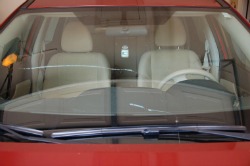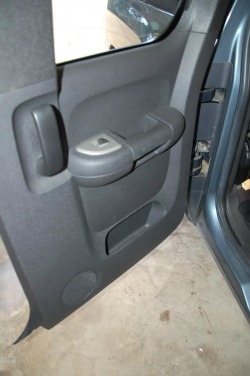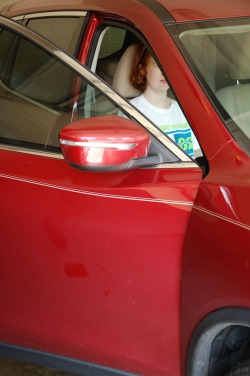Remember back in 1935 when the .357 Magnum round was introduced? It was selected for use by  many law enforcement agencies across the country. The new magnum was highly touted as being able to shoot through the block of a car and stop the engine dead. Well, I’m not sure if that is true. A vehicle’s engine and compartment makes for a pretty formidable bullet stopper. That’s a good thing when using a vehicle in a defensive position. We more or less expect (or hope) that our car, truck, or SUV will shield us somewhat during SHTF escapes, bug outs, or other defensive maneuvers.
many law enforcement agencies across the country. The new magnum was highly touted as being able to shoot through the block of a car and stop the engine dead. Well, I’m not sure if that is true. A vehicle’s engine and compartment makes for a pretty formidable bullet stopper. That’s a good thing when using a vehicle in a defensive position. We more or less expect (or hope) that our car, truck, or SUV will shield us somewhat during SHTF escapes, bug outs, or other defensive maneuvers.
Is the composition of a vehicle enough to protect you from incoming bullets? Some recent field trials bring new light to this question. The results are both good and bad.
A Thin Veil
First, understand that the exterior skins of nearly all conventional vehicles will not stop bullets from most handguns. The field trial did not test rifles, but it did test 12-gauge shotgun buckshot and slugs. Other reports suggest some rifle calibers such as the 5.56/223 fair no better, but the .308 does have some penetration success.
Interior Construction
The good news is that inside the doors and panels of a vehicle are a conglomeration of parts,  window winding mechanisms, radio speaker magnets, crash beams, wiring, and other fixtures. These components seem to deter, slow down, or stop bullets quite well.
window winding mechanisms, radio speaker magnets, crash beams, wiring, and other fixtures. These components seem to deter, slow down, or stop bullets quite well.
The field trial I studied used traditional bullets and loads in the .380 ACP, 9mm, .40 S&W, .45 ACP, and 12 gauge. None of the pistol bullets had much success in fully penetrating a vehicle if the bullets struck an auto component. The exception to this is with certain types of .45 ACP bullets. Full metal jacketed bullets in the .45 produced some level of success in busting through a vehicle door.
If these bullets ferreted past one of these structural fixtures or parts, then the occupant could be struck, albeit to a lesser damaging threat. Engine compartments including the radiator, water pump, and manifolds resisted penetration. Wheel wells provide a good defensive position, although exterior coverage is far from complete. It is difficult for an adult to huddle behind a car wheel and tire without being somewhat exposed.
I was recently instructed that the door beams between the front and rear doors offer a fair deflective structure for most handgun bullets. In fact, the reason low-riding thugs are crunched down in their seats with their heads positioned behind this middle door jamb component is to avoid bullet penetration to the head. Considering this part of the vehicle can stop incoming rounds, this strategy makes sense.
The Shotgun Conundrum
Likewise, the shotgun buckshot did not perform as well as one might believe. I think most of us rely upon a good 00 buckshot load to sail through just about anything. Maybe we have been watching too many movies. The buckshot pellets passed through car skins, but were then caught up by crash struts, electric window motors, door locks and other mechanisms.
The 12 gauge slug was extremely effective. These loads punched right through both the exterior and interior panels of the test car, entered the ballistic gelatin and passed completely through the entire mold. Bad news bears for those inside a vehicle.
exterior and interior panels of the test car, entered the ballistic gelatin and passed completely through the entire mold. Bad news bears for those inside a vehicle.
Read More: Tru-Bore 12 Gauge Chamber Adapter
The shotgun slug should prove a highly viable choice, if you have to be shooting at an individual inside a vehicle. While this strategy may be effective, keep in mind the skill it takes to properly shoot a slug load from a shotgun. It would be wise to consider using shotgun slugs in a self-defense scenario.
Keep in mind that the recoil and muzzle blast can be abusive. Decide if you need to go to a full 3-inch shotshell slug or if the standard 2 ¾ -inch can do the job. The field report I studied did not specify this.
Auto Glass Resistance
Now let’s get some clarity on glass. Today’s automotive glass is far superior to auto glass of the past. Contemporary windshields, side windows, and rear glass are more durable and crash resistant. Moreover, modern auto glass produces cleaner fractures. This is a plus for armed interactions and for passenger protection.
Current auto glass is much more likely to deflect pistol bullets shot from various angles due to the composition of the materials and the rake of auto glass panels. The “rake” of a windshield is the angle at which it rests inside the car frame. For example, a sporty car or pickup truck has a windshield with a sharper rake. By contrast, some Jeep models have front glass that stands square to the frame.
A severe auto glass rake helps deflect bullets and may prevent penetration inside the vehicle cabin.  Of course, this is often contingent on the angle of the shot. In the field trials report, most of the pistol bullets did not completely penetrate the plate glass panel. The glass may have cracked and fragmented, but the bullets did not pass through.
Of course, this is often contingent on the angle of the shot. In the field trials report, most of the pistol bullets did not completely penetrate the plate glass panel. The glass may have cracked and fragmented, but the bullets did not pass through.
So, while modern auto glass cannot be relied upon to provide complete passenger protection, it certainly affords a better barrier than older auto glass. When engaging an adversary, putting several layers of glass between yourself and incoming bullets offers extra protection.
In practice this might mean hiding at the rear quarter panel of the vehicle thus putting the rear glass, side glass, and a windshield between yourself and an assailant shooting from a position in front of the vehicle.
Also Read: Dumpster Diving Urban Survival Food Strategy
So, there you go. A vehicle is a reasonable barrier against oncoming gun fire unless the attacker happens to be using shotgun slugs. If a pistol bullet dodges mechanisms inside a door, the passenger could certainly be wounded. The same would occur if the bullet’s pathway hit glass just right. However, I would rather have the structure of a vehicle in my favor than be standing out in the open.
Photos By:
John J. Woods

9 comments
Whenever you stop in traffic, ALWAYS make sure to leave enough space between you and the vehicle in front of you so that you can take evasive action to reverse your travel direction. NEVER get boxed in and you’ll NEVER have to rely on your auto to stop a bullet. I learned this from an old native American individual, just before he was run over by a moving van.
bizarre
Actually, it does work, IF, YOU, can see the tires of the vehicle in front of you on the pavement/roadbed, (as in making contact, not just seeing the tops of the tires)you already have room to maneuver around that stopped vehicle, IF, you have the space on either side.
Once I had the privilege of shooting up an old car, 70’s Plymouth, that was rescued from a tow yard and was going to be scrapped. We got to play with it before hand. Shot it with long barreled AR and short barreled with 64 grain power points in the rear panel. The long barreled AR had higher velocity and the bullet broke up and wouldn’t penetrate the second side of the car. The short barreled AR sent the same bullet through both sides. .270 soft points blew up and wouldn’t go through both sides. On the drivers door, 12 gauge 00 buck went right through the exterior door skin, but bounced off the interior door panel on the same door (never actually made it into the passenger compartment). .40 S&W hollow points barely made it through the first door with any energy left. .45 ACP FMJ zipped through both sides.
Okay, the important question (at least for me) is what DIY measures can one take to increase one’s survivability when in a vehicle being shot at? Do glass laminates applied to the interior/exterior of your vehicle’s windows have any value? Since protecting the driver is paramount to keeping your vehicle moving (a stationary target is a easier target), his/hers protection must come first IMHO (sorry dear). Are there kevlar-based seat covers to provide extra protection from behind? Are there clear ballistic barriers made to bolt onto your dash board and/or side window (or entire door)? Can you legally add gun ports to your vehicle to return fire if needed and is this even likely to be workable since any target outside of your vehicle (especially if it’s stopped) is probably going to be somewhat mobile and thus hard to engage? A first-aid kit and small fire extinguisher within arms reach would seem like a good ideal (as well as a firearm)! Are there DIY run-flat inserts (like the solid-foam ones for bicycle tires) available for motorized vehicles? This possible scenario is only survivable in an enclosed vehicle, a motorcycle, well, maybe not! Hollyweird makes a gun-shot-to-the-gas-tank explosion seem not only likely but probable! Is this so and if so, is there a kevlar-based sack to enclose your gas tank to prevent this from occurring! Are there some vehicles that are already safer from this kind of assault other than the obvious armored vehicle? GLAHP! (Good Luck and Happy Prepping!) (Might as well enjoy yourself!)
Roger,
Any high quality tint (and there are ballistic specific ones -3M and others) will protect the glass to a certain extent. What they’ll do is allow the bullet through, but keep the rest of the glass from shattering and collapsing. This would also greatly protect your vehicle from thrown items. You can also buy run-flat tires. Michelin makes them for common passenger cars. You can make your vehicle completely armored as long as you have LOTS of money to throw at it, but you’ll overload your suspension to where you have no cargo capacity (due to weight), poor maneuverability, cut your fuel economy in half, and risk constant break down due to an overtaxed drive train, etc. If this is a bug out vehicle you’re dreaming about, then avoidance is your best strategy because during the chaos of that event there are so many ways for your vehicle to be disabled and you should be physically and psychologically prepared to continue on foot. If this is some sort of rolling battle wagon you’re dreaming of, your adventure will likely be short lived as there are even more things that could go wrong.
Most auto side glass will indeed allow even a .22lr round fired from a handgun, penetrate the glass and strike an occupant. Film of any kind helps keep that glass together, as it is designed to instantly crumble into small non-cutting (in theory) bits, for “safety” in collisions.
Windshield front and rear glass is laminated and will “usually” stop most direct handgun rounds, or cause those rounds to carom off the windshield….”usually” being the incredibly subjective first hand experience of having to fire live rounds into vehicles containing incredibly violent shooting felons from a prior law enforcement career.(retired)
12 buck shot (all of it) will not penetrate car doors nor car doors with windows rolled fully or partially down. Slugs will go through doors and occupants like a knife through very warm butter.
Shooting INTO/AT any vehicle is best done with a center fire rifle, and include several rounds to ensure the vehicle is no longer a threat. Wheels (not tires) can and do sometimes stop or slow down handgun rounds enough to make them ineffective. The engine block of most production vehicles contains enough solid metal to slow down/stop most centerfire cartridges, handgun rounds, with the exception of the .338 Lapua, or the .50 caliber Barrett rounds.
Just my personal past professional experience, and yes, I’ve sought “cover and concealment” behind vehicles with “mixed”results in civilian law enforcement. I’ve also had to kiss the asphalt as low as I could, except for the buttons being in the way, on a few occasions, too. NOTHING works every time, all the time…you could get really really lucky, or have the luck of this Irisher! I like solid metal cover for being shot AT, just my personal preference is all. Great article, brings up many things to consider when/if, one cannot get away from “trouble”.
Anyone that keeps track of drug cartel border violence will have seen many photos of cars and trucks riddled with bullets. The targeted victims shown in these photos are almost invariably dead. The weapon of choice is the AK style 7.62X39. By the way, what goes for door and window penetration applies to pickup truck side panels, as well.
The Tokerov round (especially the solid core bullets) will go through almost anything. It is a 7.62 x25(.30 cal) and is very powerful for a handgun round. I am sure that this round will penetrate almost any vehicle from 100 yards or fewer.